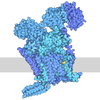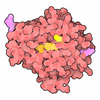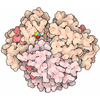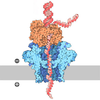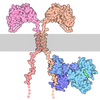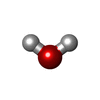Entry Database : PDB / ID : 2y3jTitle Structure of segment AIIGLM from the amyloid-beta peptide (Ab, residues 30-35) AMYLOID BETA A4 PROTEIN Keywords / Function / homology Function Domain/homology Component
/ / / / / / / / / / / / / / / / / / / / / / / / / / / / / / / / / / / / / / / / / / / / / / / / / / / / / / / / / / / / / / / / / / / / / / / / / / / / / / / / / / / / / / / / / / / / / / / / / / / / / / / / / / / / / / / / / / / / / / / / / / / / / / / / / / / / / / / / / / / / / / / / / / / Biological species HOMO SAPIENS (human)Method / / / Resolution : 1.99 Å Authors Colletier, J.P. / Laganowsky, A. / Sawaya, M.R. / Eisenberg, D. Journal : Proc.Natl.Acad.Sci.USA / Year : 2011Title : Molecular Basis for Amyloid-{Beta} Polymorphism.Authors : Colletier, J. / Laganowsky, A. / Landau, M. / Zhao, M. / Soriaga, A.B. / Goldschmidt, L. / Flot, D. / Cascio, D. / Sawaya, M.R. / Eisenberg, D. History Deposition Dec 21, 2010 Deposition site / Processing site Revision 1.0 Nov 2, 2011 Provider / Type Revision 1.1 May 8, 2024 Group / Database references / OtherCategory chem_comp_atom / chem_comp_bond ... chem_comp_atom / chem_comp_bond / database_2 / pdbx_database_status Item / _database_2.pdbx_database_accession / _pdbx_database_status.status_code_sf
Show all Show less
 Yorodumi
Yorodumi Open data
Open data Basic information
Basic information Components
Components Keywords
Keywords Function and homology information
Function and homology information HOMO SAPIENS (human)
HOMO SAPIENS (human) X-RAY DIFFRACTION /
X-RAY DIFFRACTION /  SYNCHROTRON /
SYNCHROTRON /  MOLECULAR REPLACEMENT / Resolution: 1.99 Å
MOLECULAR REPLACEMENT / Resolution: 1.99 Å  Authors
Authors Citation
Citation Journal: Proc.Natl.Acad.Sci.USA / Year: 2011
Journal: Proc.Natl.Acad.Sci.USA / Year: 2011 Structure visualization
Structure visualization Molmil
Molmil Jmol/JSmol
Jmol/JSmol Downloads & links
Downloads & links Download
Download 2y3j.cif.gz
2y3j.cif.gz PDBx/mmCIF format
PDBx/mmCIF format pdb2y3j.ent.gz
pdb2y3j.ent.gz PDB format
PDB format 2y3j.json.gz
2y3j.json.gz PDBx/mmJSON format
PDBx/mmJSON format Other downloads
Other downloads 2y3j_validation.pdf.gz
2y3j_validation.pdf.gz wwPDB validaton report
wwPDB validaton report 2y3j_full_validation.pdf.gz
2y3j_full_validation.pdf.gz 2y3j_validation.xml.gz
2y3j_validation.xml.gz 2y3j_validation.cif.gz
2y3j_validation.cif.gz https://data.pdbj.org/pub/pdb/validation_reports/y3/2y3j
https://data.pdbj.org/pub/pdb/validation_reports/y3/2y3j ftp://data.pdbj.org/pub/pdb/validation_reports/y3/2y3j
ftp://data.pdbj.org/pub/pdb/validation_reports/y3/2y3j






 Links
Links Assembly
Assembly


 Components
Components HOMO SAPIENS (human) / References: UniProt: P05067
HOMO SAPIENS (human) / References: UniProt: P05067 X-RAY DIFFRACTION / Number of used crystals: 2
X-RAY DIFFRACTION / Number of used crystals: 2  Sample preparation
Sample preparation SYNCHROTRON / Site:
SYNCHROTRON / Site:  ESRF
ESRF  / Beamline: ID23-2 / Wavelength: 0.8726
/ Beamline: ID23-2 / Wavelength: 0.8726  Processing
Processing MOLECULAR REPLACEMENT / Resolution: 1.99→45.23 Å / Cor.coef. Fo:Fc: 0.935 / Cor.coef. Fo:Fc free: 0.95 / SU B: 1.6 / SU ML: 0.047 / Cross valid method: THROUGHOUT / ESU R: 0.098 / ESU R Free: 0.052 / Stereochemistry target values: MAXIMUM LIKELIHOOD / Details: HYDROGENS HAVE BEEN ADDED IN THE RIDING POSITIONS.
MOLECULAR REPLACEMENT / Resolution: 1.99→45.23 Å / Cor.coef. Fo:Fc: 0.935 / Cor.coef. Fo:Fc free: 0.95 / SU B: 1.6 / SU ML: 0.047 / Cross valid method: THROUGHOUT / ESU R: 0.098 / ESU R Free: 0.052 / Stereochemistry target values: MAXIMUM LIKELIHOOD / Details: HYDROGENS HAVE BEEN ADDED IN THE RIDING POSITIONS. Movie
Movie Controller
Controller






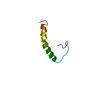



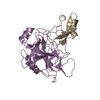
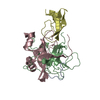









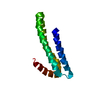











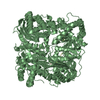

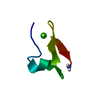


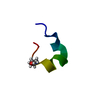
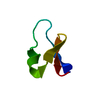

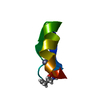
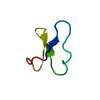
 PDBj
PDBj






